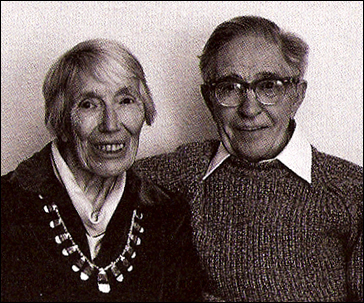Santa Fe Living Treasures – Elder Stories
<<Back to Treasures Index Harmon & | Harmon & Cornelia HullCornelia Hull is compiling a book of her husband's wartime letters home. "Harmon tried to write four or five times a week, so it's a historical document," she told us. During the Second World War, her husband, a physician, served in the China, Burma, India theater. He headed a hospital at Kwei-Lin that was destroyed by the Japanese. Harmon and Cornelia Hull met in Galveston, Texas, where both were studying medicine. Harmon was born in 1903 in Fairwater, Wisconsin; Cornelia in 1904 in Chautauqua County, New York. They married in 1930. Harmon completed his residency in Richmond, Virginia. They settled in Wisconsin and raised four sons: Pieter, Bruce, Stephen, and Douglas. Harmon was a general practitioner, a charter member of the Academy of Family Practice. Cornelia, her medical studies sidetracked by the Depression and the war, threw her energies into community work, school board, League of Women Voters, and the Waupan Council on Human Relations. Organized by League members, the Council was a community (as opposed to church) effort on behalf of migrant workers. "We understood," Cornelia says, "that it was the first community project of its kind... in the country." Mexican-Americans from the Texas border arrived in the Waupan area each spring to work in the sugar beet fields and stayed right through the fall before moving on to the orchards of the Northwest. Their children never saw the inside of a school, until Cornelia and colleagues got going. They opened a pioneer bilingual school, staffed by Spanish speaking students from University of Wisconsin; they started health and housing programs and opened the local swimming pool to migrant families. Cornelia also served on the Governor's Commission on Human Rights, under four Wisconsin governors. The Hulls moved to Santa Fe in 1968. Disturbed by the lack of affordable housing in his new community, Harmon bought a few old condemned houses on the west side. "He thought we should renovate them, make them attractive, and then have the people who had been living in them before be able to move back in without having to pay more rent. It was his little personal Habitat for Humanity." Please see Volume 1 for complete text. |
